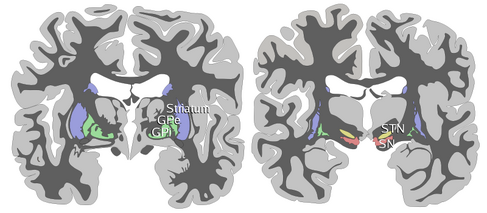Assessment |
Biopsychology |
Comparative |
Cognitive |
Developmental |
Language |
Individual differences |
Personality |
Philosophy |
Social |
Methods |
Statistics |
Clinical |
Educational |
Industrial |
Professional items |
World psychology |
Biological: Behavioural genetics · Evolutionary psychology · Neuroanatomy · Neurochemistry · Neuroendocrinology · Neuroscience · Psychoneuroimmunology · Physiological Psychology · Psychopharmacology (Index, Outline)

Coronal slices of human brain showing the basal ganglia, globus pallidus: external segment (GPe), subthalamic nucleus (STN), globus pallidus: internal segment (GPi), and substantia nigra (SN).
The striatum is a subcortical part of the brain consisting of the caudate nucleus and the putamen. It is part of the basal ganglia. The striatum is best known for its role in the planning and modulation of movement pathways but is also involved in a variety of other cognitive processes involving executive function.
The striatum consists mainly of GABAergic medium spiny neurons, but medium aspiny neurons and large aspiny neurons can also be found along with cholinergic interneurons.
In humans the striatum is activated in the presence of stimuli associated with reward, but also in the presence of aversive, novel, unexpected or intense stimuli, and cues associated with such events. Recent fMRI evidence suggests that the common property linking these stimuli, to which the striatum is reacting, is saliency under the conditions of presentation. A number of other brain areas and circuits are also related to reward, including the nucleus accumbens and other frontal areas.
The main efferent target of the striatum is the globus pallidus, which is primarily inhibited by GABAergic synapses from the striatum. The main afferent region to the striatum is neocortex. Cortical pyramidal cells project glutamatergically to the striatum, exciting striatal neurons. The substantia nigra projects dopaminergic axons to the striatum via the nigrostriatal pathway, which is part of the medial forebrain bundle. While cortical axons synapse mainly on spine heads of medium spiny neurons, nigral axons synapse mainly on spine shafts. Metabotropic dopamine receptors are present both on medium spiny neurons and on cortical axon terminals. Second-messenger cascades triggered by activation of these dopamine receptors can modulate pre- and post-synaptic function, both in the short term and in the long term.
Parkinson's disease results from loss of dopaminergic innervation to the striatum. It is also thought that addiction involves plasticity at striatal synapses.
External links[]
- BrainMaps at UCDavis striatum
- BrainInfo at the University of Washington hier-207
- MeSH Corpus+Striatum
References[]
- Zink, C. F., Pagnoni, G., Martin-Skurski, M. E., Chappelow, J. C., & Berns, G. S (2004). Human striatal responses to monetary reward depend on saliency. Neuron, 42, 509-517.
de:Corpus striatum es:Cuerpo estriado he:סטריאטום
| This page uses Creative Commons Licensed content from Wikipedia (view authors). |